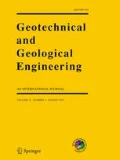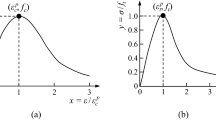Abstract
Induced stresses in sprayed concrete (or shotcrete) are quite complex to evaluate and depend on many factors such as the size and depth of the tunnel, the geomechanical characteristics of the surrounding ground in which the tunnel is excavated, the type of shotcrete, the evolution of its mechanical parameters over time and the excavation face advance rate. In particular, the evolution of the mechanical properties of the shotcrete is crucial regarding the interaction with the tunnel wall and the development of the bending moments and the normal forces which occur along the circumference of the lining. In this research, a new calculation procedure based on the combined use of two calculation methods, the convergence confinement and the hyperstatic reaction methods, is presented. Thanks to this procedure, it is possible to progressively apply the load acting on the lining as the curing phase of the concrete progresses and therefore with the evolution of its mechanical parameters. This procedure has been applied to several examples of calculation, obtaining useful considerations regarding the mechanical behavior of the shotcrete lining when some fundamental parameters of the calculation change. It is possible to achieve bending moments and forces in the lining with the progress of the load steps. It is also possible to determine the trend of the lining safety factor over time and at the end of the loading phase, allowing a proper design of the support, with particular attention to the type of shotcrete and the thickness of the lining.

(picture courtesy Roland Mayr, BASF)

(modified after Oreste 2009)












Similar content being viewed by others
Abbreviations
- A :
-
Area of the lining section
- \(E_{rm}\) :
-
Elastic modulus of the rock mass
- \(E_{,mean }\) :
-
Mean value of the elastic modulus of shotcrete
- \(E_{, t}\) :
-
Elastic modulus of shotcrete at the time \(t\)
- \(E_{, 0}\) :
-
Value of the asymptotic elastic modulus of the shotcrete, for \(t = \infty\)
- \(\left\{ F \right\}\) :
-
Nodal forces applied to the numerical model
- \(J_{z}\) :
-
Moment of inertia of the lining section
- \(K\) :
-
Global stiffness matrix
- \(k_{i }\) :
-
Local stiffness matrix of the element i
- \(K_{n}\) :
-
Normal stiffness of the interaction spring in the node of the model
- \(K_{0}\) :
-
Lateral earth pressure
- \(K_{s}\) :
-
Shear stiffness of the interaction spring in the node of the model
- l :
-
Length of the one-dimensional element
- M :
-
Bending moment
- N :
-
Normal force
- \(p\) :
-
Internal tunnel pressure
- \(p_{cr}\) :
-
Critical pressure at the limit between the elastic and the plastic behavior
- \(p_{fict}\) :
-
Fictitious internal tunnel pressure
- \(p_{0}\) :
-
Lithostatic pressure
- \(R\) :
-
Tunnel radius
- \(r\) :
-
Generic radial coordinate
- \(\left\{ S \right\}\) :
-
Vector of nodal displacements
- T :
-
Shear force
- \(t_{0}\) :
-
Final installation time of the support
- \(u\) :
-
Tunnel wall radial displacement
- v :
-
Poisson’s ratio
- \(\alpha\) :
-
Time constants \((t^{ - 1} )\) of the curing equation for the elastic modulus
- \(\alpha_{i}\) :
-
Angle of inclination of the element ith with respect to the horizontal
- \(\phi\) :
-
Rotation of the element in correspondence to the nodes
- \(\delta\) :
-
Advance step
- \(\delta n\) :
-
Nodal normal displacement between the structure and the rock mass
- \(\delta s\) :
-
Shear displacement between the structure and the rock mass
- \(\sigma_{c,t}\) :
-
Unconfined compressive strength for the shotcrete at the time t
References
Chang Y, Stille H (1993) Influence of early age properties of shotcrete on tunnel construction sequences. In: Wood DF, Morgan DR (eds) Shotcrete for underground support VI. American Society of Civil Engineers, Reston, pp 110–117
Clements M (2004) Comparison of methods for early age strength testing of sprayed fibre reinforced concrete. In: Bernard ES (ed) Proceedings of the 2nd international conference on engineering developments in sprayed fibre reinforced concrete, Cairns, Queensland, Australia. Taylor and Francis Group, London, pp 81–87
Concrete Institute of Australia (2010) Shotcrete in Australia. Concrete Institute of Australia, Rhodes
DIN EN 12504-1 (2009) Prüfung von Beton in Bauwerken—Teil 1: Bohrkernproben—Herstellung, Untersuchung und Prüfung der Druckfestigkeit. Deutsches Institut fur Normung, e.V
DIN EN 14487-1 (2006) Spritzbeton—Teil 1: Begriffe, Festlegungen und Konformität. Deutsches Institut fur Normung, e.V
DIN EN 14488-2 (2006) Prüfung von Spritzbeton—Teil 2: Druckfestigkeit von jungem Spritzbeton. Deutsches Institut fur Normung, e.V
DIN 18551 (1992) Spritzbeton—Nationale Anwendungsregeln zur Reihe DIN EN 14487 und Regeln für die Bemessung von Spritzbetonkonstruktionen. Deutsches Institut fur Normung, e.V
Do NA, Dias D, Oreste P, Djeran-Maigre I (2014a) The behavior of the segmental tunnel lining studied by the hyperstatic reaction method. Eur J Environ Civ Eng 18(4):489–510
Do NA, Dias D, Oreste P, Djeran-Maigre I (2014b) A new numerical approach to the hyperstatic reaction method for segmental tunnel linings. Int J Numer Anal Methods Geomech 38:1617–1632
Franzen T, Garshol KF, Tomisawa N (2001) Sprayed concrete for final lining: ITA working group report. Tunn Undergr Space Technol 16:295–309
Hemphill GB (2013) Practical tunnel construction. Wiley, Hoboken
Iwaki K, Hirama A, Mitani K, Kaise S, Nakagawa K (2001) A quality control method for shotcrete strength by pneumatic pin penetration test. NDT E Int 34(6):395–402
Jolin M, Beaupré D (2003) Understanding wet-mix shotcrete: mix design, specifications, and placement. Shotcrete magazine, pp 6–12
Melbye T (1994) Sprayed concrete for rock support. MBT International Underground Construction Group, Zürich
Mohajerani A, Rodrigues D, Ricciuti C, Wilson C (2015) Early-age strength measurement of shotcrete. J Mater. https://doi.org/10.1155/2015/470160
Oreste P (2003) Procedure for determining the reaction curve of shotcrete lining considering transient conditions. Rock Mech Rock Eng 36(3):209–236. https://doi.org/10.1007/s00603-002-0043-z
Oreste P (2007) A numerical approach to the hyperstatic reaction method for the dimensioning of tunnel supports. Tunn Undergr Space Technol 22:185–205
Oreste P (2009) The convergence-confinement method: roles and limits in modern geomechanical tunnel design. Am J Appl Sci 6(4):757–771
Oreste P (2014) The determination of the tunnel structure loads through the analysis of the interaction between the void and the support using the convergence-confinement method. Am J Appl Sci 11(11):1945–1954
Oreste P, Spagnoli G, Luna Ramos CA, Sebille L (2018) The hyperstatic reaction method for the analysis of the sprayed concrete linings behavior in tunneling. Geotech Geol Eng 36(4):2143–2169. https://doi.org/10.1007/s10706-018-0454-6
ÖVBB (2006) Guideline sprayed concrete. Österreichische Bautechnik Vereinigung, Vienna
Panet M, Guenot A (1982) Analysis of convergence behind the face of a tunnel. In: Proceedings of the tunnelling, vol 82, Brighton, pp 197–204
Pottler R (1990) Time-dependent rock-shotcrete interaction. A numerical shortcut. Comput Geotech 9:149–169
Prudencio LR (1998) Accelerating admixtures for shotcrete. Cement Concr Compos 20:213–219
Rispin M, Howard D, Kleven OB, Garshol K, Gelson J (2009) Safer, deeper, faster: sprayed concrete—an integral component of development mining. Australian Centre for Geomechanics, Perth
Spagnoli G, Oreste P, Lo Bianco L (2017) Estimation of shaft radial displacement beyond the excavation bottom before installation of permanent lining in nondilatant weak rocks with a novel formulation. Int J Geomech 17:04017051. https://doi.org/10.1061/(ASCE)GM.1943-5622.0000949
Thomas A (2009) Sprayed concrete lined tunnel. Taylor & Francis, Oxon
Wang J, Niu D, Zhang Y (2015) Mechanical properties, permeability and durability of accelerated shotcrete. Constr Build Mater 95:312–328
Author information
Authors and Affiliations
Corresponding author
Rights and permissions
About this article
Cite this article
Oreste, P., Spagnoli, G. & Luna Ramos, C.A. The Elastic Modulus Variation During the Shotcrete Curing Jointly Investigated by the Convergence-Confinement and the Hyperstatic Reaction Methods. Geotech Geol Eng 37, 1435–1452 (2019). https://doi.org/10.1007/s10706-018-0698-1
Received:
Accepted:
Published:
Issue Date:
DOI: https://doi.org/10.1007/s10706-018-0698-1




